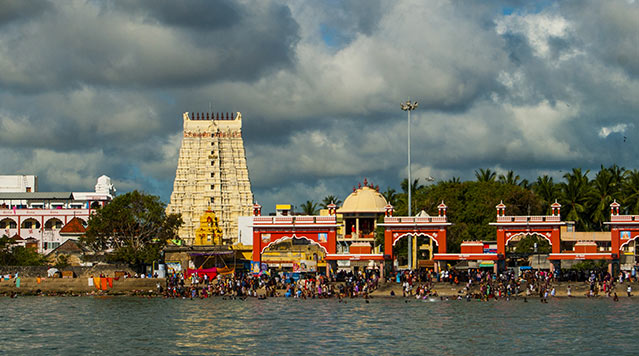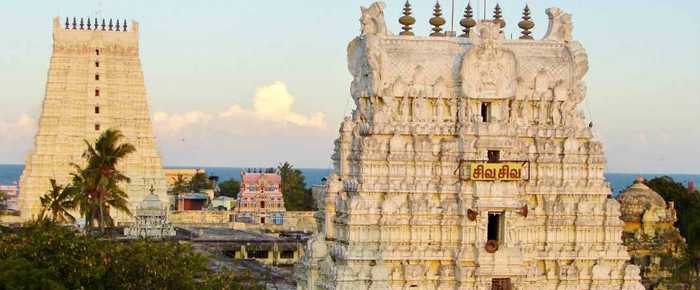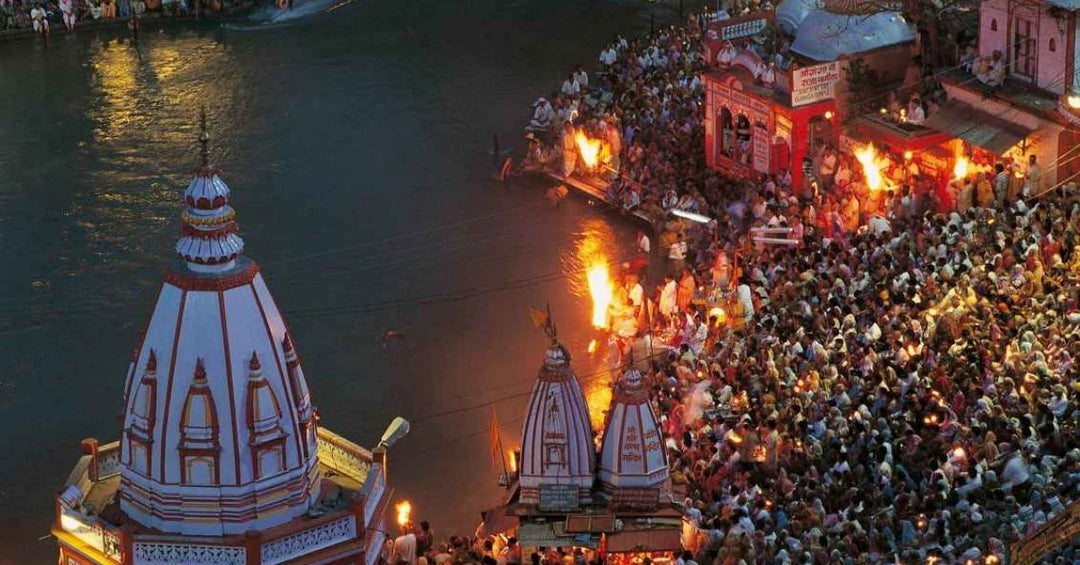About Ramanathaswamy Temple

The Ramanathaswamy Temple, located in the sacred town of Rameswaram in the southern Indian state of Tamil Nadu, is one of India's most revered and ancient Hindu temples. This magnificent temple holds profound religious significance and is dedicated to Lord Shiva, worshipped here as Ramanathaswamy, and his consort, Goddess Parvati, known as Parvathavardhini.
The Ramanathaswamy Temple is a place of worship and a symbol of architectural splendor. It is renowned for its intricate and Dravidian-style architecture, featuring a large gopuram (tower) at the entrance adorned with colorful sculptures, and a magnificent corridor with 1,000 pillars, each uniquely carved.
What sets this temple apart is its association with the epic Hindu mythological tale of Lord Rama. According to legend, Lord Rama, along with his divine consort Sita and devoted brother Lakshmana, stayed in Rameswaram during their quest to rescue Sita from the demon king Ravana. To seek forgiveness for the act of killing Ravana, who was a Brahmin, Lord Rama wanted to install a lingam (an abstract representation of Lord Shiva) in Rameswaram. To do so, he instructed Lord Hanuman to bring a lingam from the Himalayas. However, there was a delay in Lord Hanuman's return, so Sita created a sand lingam in the meantime, which is said to be the one worshipped at the Ramanathaswamy Temple today. This lingam is believed to possess immense spiritual power and is a significant pilgrimage destination for Hindus.
The temple complex also includes sacred bathing tanks, known as "tirthas," where devotees take ritual baths before entering the temple to purify themselves spiritually. The Agni Teertham, the sea-facing tank, is especially important, as it is believed that Lord Rama worshiped Lord Shiva here.
Every year, thousands of pilgrims from all over India and beyond visit the Ramanathaswamy Temple to seek blessings, perform ancestral rituals, and immerse themselves in the rich religious and cultural heritage of this sacred site. The temple's serene atmosphere and architectural grandeur make it not only a spiritual sanctuary but also a place of historical and cultural significance.
What is special about Ramanathaswamy temple?
The Ramanathaswamy Temple in Rameswaram, Tamil Nadu, is a unique and special Hindu temple for several reasons:
Religious Significance: The temple is dedicated to Lord Shiva, known as Ramanathaswamy, and is one of the twelve Jyotirlinga shrines, which are considered the holiest abodes of Lord Shiva in Hinduism. It holds great religious importance for Shiva devotees.
Epic Connection: The temple is closely associated with the epic Hindu mythological tale of Lord Rama. According to legend, Lord Rama and his divine consort, Sita, stayed in Rameswaram during their quest to rescue Sita from the demon king Ravana. Lord Rama wanted to seek forgiveness for the act of killing Ravana, who was a Brahmin, and thus, he instructed the creation of a unique lingam (an abstract representation of Lord Shiva) in the temple. This lingam, known as the "Ramanathaswamy Lingam," is believed to be the one worshipped in the temple today, making it an essential part of the Ramayana narrative.
Architectural Marvel: The temple's Dravidian-style architecture is a testament to the artistic and architectural skills of ancient India. It features a massive gopuram (tower) at the entrance adorned with intricate sculptures and a magnificent corridor with 1,000 ornately carved pillars. The temple's architectural beauty is a sight to behold.
Holy Teerthams: The temple complex includes 22 sacred bathing tanks, known as "teerthams," where devotees take ritual baths before entering the temple. The Agni Teertham, located at the seashore, is particularly significant, as it is believed that Lord Rama worshiped Lord Shiva here. Pilgrims believe that taking a dip in these tirthas purifies their souls.
Pilgrimage Destination: The Ramanathaswamy Temple is one of the most prominent pilgrimage destinations in India. Devotees from all over the country and beyond visit the temple to seek blessings, perform ancestral rituals, and offer prayers. It is an integral part of the Char Dham Yatra pilgrimage, which includes four sacred destinations for Hindus.
Spiritual Power: The Ramanathaswamy Lingam is believed to possess immense spiritual power, and devotees believe that offering prayers and performing rituals at this temple can bring them inner peace and divine blessings.
Historical and Cultural Heritage: Beyond its religious significance, the temple is a repository of historical and cultural heritage. Its association with the Ramayana, along with its architectural splendor, makes it a vital cultural landmark in India.
In summary, the Ramanathaswamy Temple is special due to its religious significance, epic connection to Lord Rama, stunning architecture, sacred tirthas, and its role as a revered pilgrimage destination and cultural icon in India. It remains a place of deep spiritual and cultural importance for millions of devotees.
Why is Rameshwaram temple famous?

The Rameshwaram Temple, also known as the Ramanathaswamy Temple, stands out as a renowned and culturally significant religious site in India. Its fame is rooted in several remarkable facets:
Ramayana Connection: The temple's illustrious reputation is intertwined with the Hindu epic, the Ramayana. Legend has it that Lord Rama, accompanied by his consort Sita and loyal brother Lakshmana, sought refuge in Rameswaram during their quest to rescue Sita from the clutches of the demon king Ravana. To atone for the act of slaying Ravana, who was a Brahmin, Lord Rama desired to install a lingam (an abstract representation of Lord Shiva) in Rameswaram. The very lingam he intended to establish, referred to as the "Ramanathaswamy Lingam," is believed to be the principal deity worshipped in the temple today. This deep-rooted connection to the Ramayana narrative makes the temple an iconic pilgrimage destination for devotees of Lord Rama.
Jyotirlinga Status: Adding to its prominence, the Ramanathaswamy Temple is recognized as one of the twelve Jyotirlinga shrines, held in the highest reverence among Lord Shiva devotees. These Jyotirlingas are venerated as the holiest abodes of Lord Shiva in Hinduism, elevating the status of the Rameshwaram Temple in the eyes of spiritual seekers.
Architectural Grandeur: The temple's architectural magnificence is a captivating sight. Exhibiting the striking Dravidian architectural style, it boasts a majestic gopuram (tower) at its entrance adorned with intricate sculptures. Inside, a breathtaking corridor adorned with 1,000 exquisitely carved pillars further showcases the artistic prowess of ancient India. This architectural opulence adds to the temple's allure and cultural significance.
Sacred Teerthams: The temple complex encompasses a remarkable 22 sacred bathing tanks, known as "teerthams." Pilgrims traditionally take ritual baths in these tirthas before entering the temple premises, believing that the act purifies their souls. Of particular note is the Agni Teertham, located at the seashore, as it is believed to be the very spot where Lord Rama paid obeisance to Lord Shiva. These teerthams hold deep spiritual value for devotees.
Pilgrimage Destination: The Ramanathaswamy Temple is not only a place of worship but also a prominent pilgrimage destination. Devotees from across India and beyond embark on pilgrimages to this sacred site, seeking divine blessings, performing ancestral rituals, and offering prayers. The temple plays a pivotal role in the revered Char Dham Yatra, a pilgrimage circuit encompassing four significant Hindu pilgrimage destinations.
In summary, the Rameshwaram Temple, known as the Ramanathaswamy Temple, has achieved fame and reverence through its profound religious significance, deep-rooted connection to the Ramayana, elevated status as a Jyotirlinga shrine, awe-inspiring architectural splendor, sacred tirthas, pivotal role as a pilgrimage destination, spiritual sanctity, and its enduring position in India's historical and cultural tapestry. It remains an enduring symbol of spirituality and cultural heritage for millions of devotees and admirers.
Can we touch shivling in Rameshwaram
Yes, you can touch the Shivling (the representation of Lord Shiva) at the Ramanathaswamy Temple in Rameswaram, Tamil Nadu, India. Unlike some other Hindu temples where the central deity may be restricted from direct physical contact, the tradition at the Ramanathaswamy Temple allows devotees to have direct access to the Shivling.
Devotees visiting the temple are generally allowed to perform abhishekam (ritual bathing of the lingam) and offer prayers by touching or applying sacred materials like holy water, milk, or sandalwood paste to the Shivling as a form of reverence and devotion. It's important to follow the temple's guidelines and respect the customs and traditions while visiting and interacting with the deity. Additionally, it's advisable to maintain decorum and observe proper etiquette when inside the temple premises to ensure a respectful and spiritually fulfilling experience.
The Historical story of Rameswaram temple

The historical narrative of the Rameswaram Temple, also known as the Ramanathaswamy Temple, spans centuries and is deeply rooted in India's religious and cultural heritage. Its origins can be traced back to ancient times, with references dating to the Ramayana, a tale believed to have unfolded millennia ago. In the Ramayana, Lord Rama, accompanied by Sita and Lakshmana, sought refuge in Rameswaram during their quest to rescue Sita from the demon king Ravana. It was here that Lord Rama, eager to atone for the act of killing Ravana—a Brahmin and devotee of Lord Shiva—resolved to establish a lingam, a representation of Lord Shiva, in Rameswaram. While awaiting the return of Lord Hanuman with a lingam from the Himalayas, Sita, in her divine wisdom, created a lingam using seashore sand, known as the "Ramanathaswamy Lingam." This lingam, believed to be the primary deity of the Rameswaram Temple, became central to the temple's identity. Over the centuries, the temple underwent various phases of construction and renovation under different dynasties and rulers, each contributing to its architectural grandeur. Today, with its Dravidian-style architecture, towering gopuram, and a mesmerizing corridor adorned with 1,000 intricately carved pillars, the Rameswaram Temple stands as a testament to India's artistic and architectural brilliance. Beyond its physical splendor, it remains a symbol of spiritual devotion and a cherished pilgrimage destination, continuing to inspire millions of devotees worldwide.
The rules for Ramanathaswamy temple
The Ramanathaswamy Temple in Rameswaram, like many Hindu temples, has specific rules and guidelines for visitors and worshippers. These rules are in place to maintain the sanctity of the temple and ensure a respectful and orderly environment for devotees. Here are some common rules and guidelines for the Ramanathaswamy Temple:
Dress Code: Visitors are expected to dress modestly and conservatively. It is customary for both men and women to wear traditional attire that covers their shoulders and knees. Avoid wearing shorts, sleeveless tops, or revealing clothing.
Footwear: Footwear is not allowed inside the temple premises. Visitors must remove their shoes or sandals before entering the temple. There are designated areas for shoe storage.
Mobile Phones and Cameras: Photography and the use of mobile phones are generally not permitted inside the temple sanctum or inner areas. It's important to respect this rule to maintain the sacred atmosphere.
Purity and Cleanliness: Before entering the temple, it's customary to wash your hands and feet at the designated facilities. Devotees are also expected to be clean and bathe before visiting the temple, as a sign of physical and spiritual purity.
Offerings: If you wish to make offerings or perform rituals, it's advisable to purchase puja items from authorized sellers within the temple premises. Outside items may not be allowed.
Respectful Behavior: Maintain a respectful and quiet demeanor within the temple. Refrain from loud conversations, laughter, or disruptive behavior. Devotees often come to the temple for prayers and meditation.
Queue System: Be prepared to wait in queues, especially during peak pilgrimage seasons. Follow the instructions of temple staff and volunteers to maintain order and ensure everyone has an opportunity for darshan (viewing of the deity).
Darshan Timings: The temple has specific darshan timings for different rituals and pujas. It's a good idea to check the schedule in advance to plan your visit accordingly.
Donations and Charity: While it's not mandatory, making donations or contributing to the temple's maintenance and charitable activities is appreciated. Donation boxes are often available at various points within the temple.
Respect for Deities: Show respect to the deities and the sanctum sanctorum. Do not touch the main deity or the lingam without permission, and do not step on the sacred platform.
Silence in the Sanctum: Maintain silence and avoid unnecessary conversation when inside the sanctum sanctorum.
Non-Discrimination: The temple is open to people of all castes and backgrounds. Discrimination based on caste, religion, or gender is strictly prohibited.
Follow Local Customs: Be mindful of any specific customs or traditions followed at the Ramanathaswamy Temple and follow them respectfully.
It's important to note that rules and guidelines may vary from temple to temple, and it's always a good practice to check with temple authorities or local sources for any specific rules or changes before your visit. Adhering to these guidelines ensures a harmonious and respectful experience for all visitors and devotees.
How many years old is Rameshwaram temple?

The Rameshwaram Temple, also known as the Ramanathaswamy Temple, is estimated to be over 1,000 years old. It is one of the most famous Hindu temples in India and is located on Rameswaram Island in the state of Tamil Nadu. The exact construction date of the temple is not certain, but it has a long and rich history, making it one of the ancient and revered temples in the country.
What are the special features of Rameshwaram temple?
The Rameshwaram Temple, also known as the Ramanathaswamy Temple, is renowned for its unique and special features:
Corridor with Pillars: One of the most distinctive features of the temple is its long corridor with beautifully sculpted pillars. This corridor, also known as the "Aryabhattal Mandapam," is renowned for its architectural grandeur.
The Holy Water Tank: The temple has a sacred water tank called the "Agni Theertham," which is believed to have been blessed by Lord Rama. Devotees take ritual baths in this tank before entering the temple, considering it purifying and spiritually significant.
22 Holy Wells: Inside the temple complex, there are 22 sacred wells, each with its own unique taste and mineral properties. It is a tradition for pilgrims to visit these wells and perform rituals for purification.
Ramanathaswamy Lingam: The main deity of the temple is Lord Shiva, worshipped in the form of the "Ramanathaswamy Lingam." It is believed to have been installed by Lord Rama himself, making it of immense spiritual significance.
Floating Stones: The temple's architecture includes some unique features like floating stones. According to legend, these stones were used to build the bridge, known as "Adam's Bridge" or "Rama Setu," to Lanka (Sri Lanka) by Lord Rama's army.
Gandhamadhana Parvatham: This is a hillock located on the island that provides panoramic views of the temple and the surrounding area. It is believed to be the place where Lord Rama stood and identified the location of Lanka.
Kothandaramaswamy Temple: Located on the outskirts of Rameshwaram, this temple is dedicated to Lord Rama and has beautiful sculptures depicting scenes from the epic Ramayana.
Pilgrimage Destination: Rameshwaram is one of the Char Dham pilgrimage destinations for Hindus, along with Badrinath, Dwarka, and Puri. It holds immense religious significance and attracts millions of pilgrims and tourists each year.
Rituals and Festivals: The temple is known for its elaborate rituals and festivals, including the annual 12-day festival called "Masi Maham," during which the deities are taken in a procession to the sea. The "Aarudhra Darshan" festival is another important celebration, dedicated to Lord Nataraja.
Spiritual Importance: Rameshwaram is believed to be the place where Lord Rama prayed to Lord Shiva and sought his blessings before building the bridge to Lanka, as mentioned in the epic Ramayana. It is also one of the 12 Jyotirlinga shrines in India.
These special features, along with its historical and religious significance, make the Rameshwaram Temple a revered and unique place of worship in India.
What is the mystery of floating stones of Rameshwaram?

The "floating stones of Rameshwaram" is a term often used to describe a curious geological phenomenon observed in the region of Rameshwaram, a town located on an island in the southern part of India. These stones are not actually capable of floating in the sense of hovering above the water's surface, but the phenomenon relates to their unique buoyancy and ability to partially submerge in water.
The stones in question are primarily a type of coral reef known as "coral sandstone" or "pumice stones." They are relatively lightweight due to their porous nature and can sometimes be seen partially submerged in the shallow waters around Rameshwaram. When placed in water, these stones do indeed have the appearance of floating or buoyancy, thanks to the many air pockets within the rock.
The phenomenon of these floating-like stones has garnered attention over the years, and there have been various myths and legends associated with them, including claims that they were used to build the ancient bridge known as "Adam's Bridge" or "Rama's Bridge," which according to Hindu mythology, Lord Rama's army built to reach the island of Lanka (modern-day Sri Lanka) to rescue his wife, Sita, from the demon king Ravana.
However, from a scientific perspective, the floating stones are not directly related to the construction of any ancient bridge. Instead, they are a natural geological occurrence resulting from the composition and porous structure of the coral sandstone.
Conclusion:
In conclusion, the Ramanathaswamy Temple stands as a timeless testament to India's rich cultural and religious heritage. Its history, architecture, and spiritual significance make it a revered pilgrimage destination for millions of devotees from around the world. As we've explored in this blog, the temple's intricate design, the sacred waters of the Agni Theertham, and the legends associated with Lord Rama's visit all contribute to the temple's mystique and allure.
Visiting the Ramanathaswamy Temple is not just a religious journey but also a cultural and architectural experience that allows one to delve deep into the heart of India's spiritual tapestry. Whether you seek divine blessings, historical insights, or architectural marvels, this temple offers a profound and enriching experience that leaves an indelible mark on all who have the privilege to visit.


